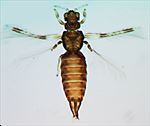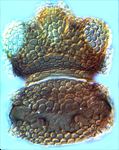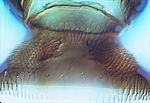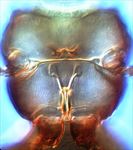





Female macropterous. Head wider than long; strongly reticulate, projecting in front of eyes, ocellar region elevated; postocular setae obscured by reticulation, occipital ridge absent, cheeks constricted at base; maxillary palps 2-segmented. Antennae 5- to 7-segmented, segment I without paired dorso-apical setae; III with one simple sense cone, IV with two simple sense cones. Pronotum strongly reticulate, no long setae. Mesonotum deeply cleft, reticulate, anteromedian campaniform sensilla absent. Metanotum strongly reticulate with triangle, median setae close to posterior margin, campaniform sensilla present. Fore wing anterior fringe cilia longer than costa setae; first and second veins with almost complete setal rows; clavus with four veinal but no discal setae; posteromarginal fringe cilia wavy. Prosternal basantra membranous, without setae; mesosternal endofurca without spinula; metasternal endofurca lyre-shaped but not reaching into mesothorax. Legs strongly reticulate, tarsi 1-segmented. Tergites with entire craspedum; tergite II anterolaterally with group of stout recurved microtrichia; III–VIII reticulate laterally, with transverse sculpture anteromedially; VIII posterior margin without comb; IX without anterior pair of campaniform sensilla; X median split complete. Sternites with entire craspedum, II–VII with three pairs of posteromarginal setae, sternite VII with two small additional setae.
Male similar to female but smaller; sense cones on antennal segments III and IV sometimes differ from female, sternites with U or V-shaped pore plates or with no pore plates.
Thripidae sub-family Panchaetothripinae: this group is represented widely around the world, particularly in tropical areas, and comprises about 40 genera. Astrothrips is one of seven genera in which the second abdominal tergite has paired anterolateral areas of stout, recurved microtrichia. These seven genera have been referred to a distinct Tribe, or even family (Bhatti, 2006), but the analysis by Mound et al. (2001) did not support such a classification.
Species of this genus feed and breed on the leaves of many different plant species, sometimes causing damage on mature leaves.
Members of this genus are found throughout the Palaeotropics, from West Africa to Northern Australia, Japan and southern China.
Astrothrips Karny, 1921: 239. Type species Heliothrips globiceps Karny 1913, by monotypy.
This genus includes 12 species (ThripsWiki, 2018), and the following three species are recorded from China :
aucubae Kurosawa, 1932: 230.
chisinliaoensis Chen, 1980: 174.
strasseni Kudo, 1979: 346.
Bhatti JS (2006) The classification of Terebrantia (Insecta) into families. Oriental Insects 40: 339–375.
Mound LA, Marullo R & Trueman JWH (2001) The greenhouse thrips, Heliothrips haemorrhoidalis, and its generic relationships within the sub-family Panchaetothripinae (Thysanoptera; Thripidae). Journal of Insect Systematics and Evolution 32: 1–12.
ThripsWiki (2018). ThripsWiki - providing information on the World's thrips. <http://thrips.info/wiki/Main_Page>